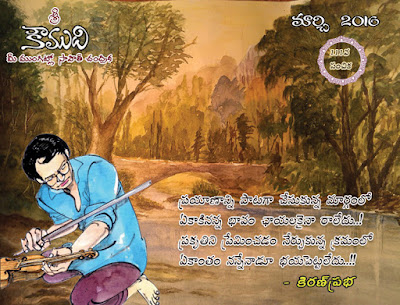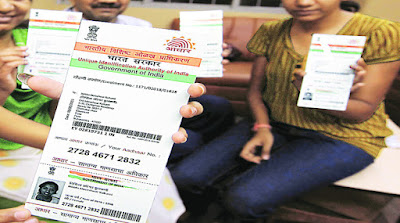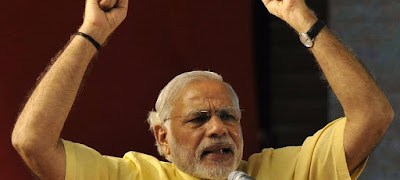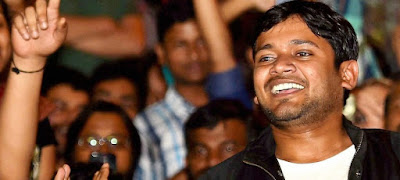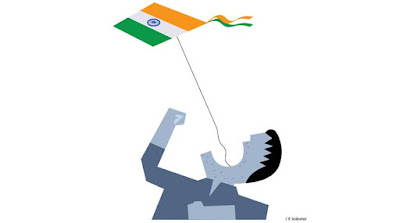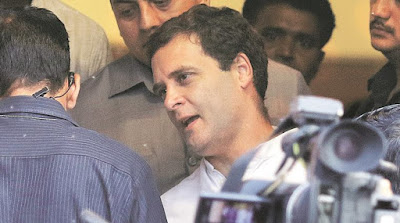It seems to me that his surety, as indeed Kanhaiya himself, must wear a hypothetical intellectual dog collar of the mind.
Written by Rajeev Dhavan | Updated: March 14, 2016 9:04 am
Kanhaiya Kumar at JNU. (Express Photo: Praveen Khanna)
Kanhaiya Kumar’s bail order is stunning. A patriotic judge’s patriotic lament. Lyricist Indeevar opens the first page of Justice Pratibha Rani’s judgment on Kanhaiya’s bail order. Imagine a chorus in court praising Hari Singh Nalwa, Lal Bahadur (Congress), Bhagat Singh (martyr), Jawahar (Congress), and the great nation swallowing up gold, diamonds and pearls. Imagine, too, shouts of encore to repeat — as the song’s tune reverberates in your mind.
What you don’t hear is Justice Krishna Iyer’s judicially consecrated slogan “Bail not jail”. Imagine the slogan “Bail not jail” being chanted, with encores galore.
If permissible, would the latter have been more appropriate? The case for bail should have been simple, based on the principles of prima facie case, seriousness of crime, prevention of the accused from absconding, non-tampering of evidence, and the requirement of cooperation with the investigation. Perhaps something could have been said about the failure of the police to protect Kanhaiya, and the intimidation of sloganeering goonda lawyers who beat him up, attacked journalists, and did not even spare a committee sent by the Supreme Court.
Bail granted, conditions imposed. Protection not ordered despite threats.
Kapil Sibal’s argument denied any slogan-raising by Kanhaiya. Additional Solicitor General Tushar Mehta, appearing for the “state”, (which state? Perhaps the State of the Nation), elaborated on the entire JNU incident, including on the posters, slogans and photographs to establish atmosphere. He even said Kanhaiya’s speech on February 11 “was part of his strategy to create a defence”. A view echoed by Justice Rani even though it was something that could not be examined at that stage.
On prima facie case, it remains a mystery as to why the learned judge cited the Gujarat High Court’s decision in Hardik Patel (2016) rather than the Supreme Court’s celebrated judgment in Kedar Nath (1962). The reference to Justice Rohinton Nariman’s view in Shreya Singhal (2015) on the “level of incitement” when restriction on free speech “kicks in” should have been a reminder for caution.
And so, was there a prima facie case? We will not exactly know because the next paragraph in the Kanhaiya bail case refers to the “vision and object of Jawaharlal Nehru University”, quoting lavishly from its website. This was to suggest that Kanhaiya betrayed his alma mater and, as emphasised later, “Our forces… protecting our frontiers in the most difficult terrain in the world, that is, Siachen Glacier or Rann of Kutch”.
The judge’s geography may be confused. The point made by the judge was that JNU protesters, too, must introspect on their slogans and displaying of photos of Afzal Guru and Maqbool Bhatt.
Indeed, the judge prescribes that JNU must take remedial steps to investigate and avoid recurrence. The general prescription suggested by the judge is “Whenever some infection is spread in a limb… [give] antibiotics orally and if that does not work… it may require surgical intervention also. [and] if the infection results in… gangrene, amputation is the only treatment”.
To whom is this advice given? To JNU? Or the state to use antibiotics and amputation to avoid the spread of this gangrene? Where? In JNU or in India — perhaps every nook and cranny of the great nation? This is in addition to her plea for introspection by all, especially the “faculty of JNU… to play its role in guiding them to the right path” for India and the university.
I guess in one sense, JNU and its staff were also on trial for failing in their national duty, as indeed Kanhaiya as president of the students’ union.
The actual discussion on bail is sparse as the learned judge found herself “standing on a cross road”, posing the question: “in view of the nature of serious allegations against him, the anti-national attitude [emphasis added] which can be gathered from the material relied upon by the state should be a ground to keep him in jail”.
Coming back to the law, the learned judge is right in saying that it was for the “investigating agency to unearth the truth” and that his later speech “cannot be examined by this court at this stage”. Then why this judicial exhortation to cure the infection which such students are suffering?
The criminal case against Kanhaiya is yet to be examined. But clearly he was morally culpable as an erring JNU student, as the president of its students’ union and as one possibly infected and who needs antibiotics and, who knows, amputation.
Not literally of course. His bail takes into account the monetary aspect that his mother is an anganwadi worker who earns Rs 3,000, and prescribes a bail bond of Rs 10,000 and a surety preferably from the teaching faculty of JNU. But morally, Kanhaiya is pronounced as being on the wrong side.
One of the considerations for his bail was that during his judicial custody, “he might have introspected about the events that had taken place… [to] enable him to remain in the mainstream”. Kanhaiya is told that as a condition for bail, he will not participate “actively or passively in any activity which may be termed as anti-national”, and as president of the JNU students’ union, he was to “make all efforts within his power to control anti-national activities in the campus”. His surety must also “exercise control… to ensure that his thoughts and energy are channelised in a constructive manner”.
It seems to me that his surety, as indeed Kanhaiya himself, must wear a hypothetical intellectual dog collar of the mind.
Justice Pratibha Rani has more to explain than Kanhaiya.
The writer is a senior advocate at the Supreme Court
Written by Rajeev Dhavan | Updated: March 14, 2016 9:04 am
Kanhaiya Kumar at JNU. (Express Photo: Praveen Khanna)
Kanhaiya Kumar’s bail order is stunning. A patriotic judge’s patriotic lament. Lyricist Indeevar opens the first page of Justice Pratibha Rani’s judgment on Kanhaiya’s bail order. Imagine a chorus in court praising Hari Singh Nalwa, Lal Bahadur (Congress), Bhagat Singh (martyr), Jawahar (Congress), and the great nation swallowing up gold, diamonds and pearls. Imagine, too, shouts of encore to repeat — as the song’s tune reverberates in your mind.
What you don’t hear is Justice Krishna Iyer’s judicially consecrated slogan “Bail not jail”. Imagine the slogan “Bail not jail” being chanted, with encores galore.
If permissible, would the latter have been more appropriate? The case for bail should have been simple, based on the principles of prima facie case, seriousness of crime, prevention of the accused from absconding, non-tampering of evidence, and the requirement of cooperation with the investigation. Perhaps something could have been said about the failure of the police to protect Kanhaiya, and the intimidation of sloganeering goonda lawyers who beat him up, attacked journalists, and did not even spare a committee sent by the Supreme Court.
Bail granted, conditions imposed. Protection not ordered despite threats.
Kapil Sibal’s argument denied any slogan-raising by Kanhaiya. Additional Solicitor General Tushar Mehta, appearing for the “state”, (which state? Perhaps the State of the Nation), elaborated on the entire JNU incident, including on the posters, slogans and photographs to establish atmosphere. He even said Kanhaiya’s speech on February 11 “was part of his strategy to create a defence”. A view echoed by Justice Rani even though it was something that could not be examined at that stage.
On prima facie case, it remains a mystery as to why the learned judge cited the Gujarat High Court’s decision in Hardik Patel (2016) rather than the Supreme Court’s celebrated judgment in Kedar Nath (1962). The reference to Justice Rohinton Nariman’s view in Shreya Singhal (2015) on the “level of incitement” when restriction on free speech “kicks in” should have been a reminder for caution.
And so, was there a prima facie case? We will not exactly know because the next paragraph in the Kanhaiya bail case refers to the “vision and object of Jawaharlal Nehru University”, quoting lavishly from its website. This was to suggest that Kanhaiya betrayed his alma mater and, as emphasised later, “Our forces… protecting our frontiers in the most difficult terrain in the world, that is, Siachen Glacier or Rann of Kutch”.
The judge’s geography may be confused. The point made by the judge was that JNU protesters, too, must introspect on their slogans and displaying of photos of Afzal Guru and Maqbool Bhatt.
Indeed, the judge prescribes that JNU must take remedial steps to investigate and avoid recurrence. The general prescription suggested by the judge is “Whenever some infection is spread in a limb… [give] antibiotics orally and if that does not work… it may require surgical intervention also. [and] if the infection results in… gangrene, amputation is the only treatment”.
To whom is this advice given? To JNU? Or the state to use antibiotics and amputation to avoid the spread of this gangrene? Where? In JNU or in India — perhaps every nook and cranny of the great nation? This is in addition to her plea for introspection by all, especially the “faculty of JNU… to play its role in guiding them to the right path” for India and the university.
I guess in one sense, JNU and its staff were also on trial for failing in their national duty, as indeed Kanhaiya as president of the students’ union.
The actual discussion on bail is sparse as the learned judge found herself “standing on a cross road”, posing the question: “in view of the nature of serious allegations against him, the anti-national attitude [emphasis added] which can be gathered from the material relied upon by the state should be a ground to keep him in jail”.
Coming back to the law, the learned judge is right in saying that it was for the “investigating agency to unearth the truth” and that his later speech “cannot be examined by this court at this stage”. Then why this judicial exhortation to cure the infection which such students are suffering?
The criminal case against Kanhaiya is yet to be examined. But clearly he was morally culpable as an erring JNU student, as the president of its students’ union and as one possibly infected and who needs antibiotics and, who knows, amputation.
Not literally of course. His bail takes into account the monetary aspect that his mother is an anganwadi worker who earns Rs 3,000, and prescribes a bail bond of Rs 10,000 and a surety preferably from the teaching faculty of JNU. But morally, Kanhaiya is pronounced as being on the wrong side.
One of the considerations for his bail was that during his judicial custody, “he might have introspected about the events that had taken place… [to] enable him to remain in the mainstream”. Kanhaiya is told that as a condition for bail, he will not participate “actively or passively in any activity which may be termed as anti-national”, and as president of the JNU students’ union, he was to “make all efforts within his power to control anti-national activities in the campus”. His surety must also “exercise control… to ensure that his thoughts and energy are channelised in a constructive manner”.
It seems to me that his surety, as indeed Kanhaiya himself, must wear a hypothetical intellectual dog collar of the mind.
Justice Pratibha Rani has more to explain than Kanhaiya.
The writer is a senior advocate at the Supreme Court
Source: indianexpress


